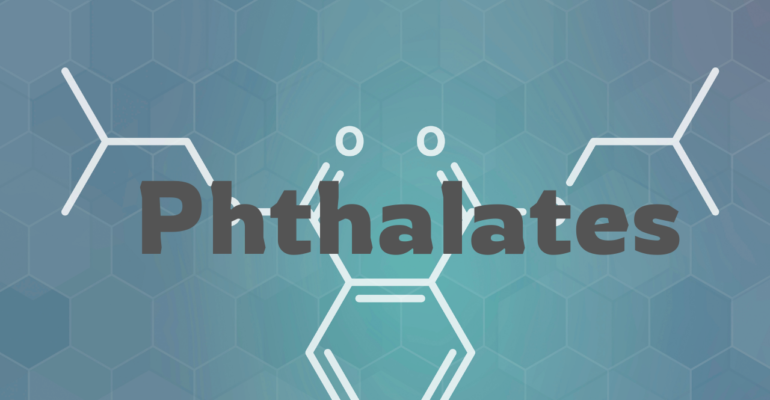Phthalates in Skincare and Consumer Products: Sources, Side Effects, and Safer Alternatives
September 2, 2021 2025-04-21 7:22Phthalates in Skincare and Consumer Products: Sources, Side Effects, and Safer Alternatives
As an Amazon associate, Dermatocare earns from valid purchase made by clicking on the affiliate links in this blog.

Phthalates in Skincare and Consumer Products: Sources, Side Effects, and Safer Alternatives
What Are Phthalates?
Phthalates (pronounced thal-ates) are a group of synthetic chemicals widely used as plasticizers to enhance the flexibility, durability, and longevity of plastics. They are also found in numerous cosmetics, personal care products, and industrial applications.
Despite their widespread use, phthalates are classified as endocrine-disrupting chemicals (EDCs), meaning they can interfere with hormonal systems. This article summarizes the latest peer-reviewed evidence on phthalates’ health and dermatological impacts, compiled from current studies indexed on PubMed and related databases.
Common Sources of Phthalates
1. Personal Care Products:
- Perfumes, deodorants, nail polish, hairsprays, lotions, shampoos, and fragranced skincare products.
- Often present as “hidden” ingredients under the term fragrance or parfum.
2. Household Products:
- Detergents, plastic wraps, vinyl flooring, shower curtains, wallpaper, food packaging, children’s toys, and cleaning products.
3. Medical and Pharmaceutical Items:
- IV tubing, blood bags, nutritional supplements, vinyl gloves, enteric-coated tablets, and some pharmaceutical coatings.
4. Industrial Applications:
- Solvents, adhesives, plastic coatings, automotive parts, and construction materials.
How Are We Exposed?
Phthalates are not chemically bound to the materials they are added to, allowing them to leach into air, water, food, and skin upon contact. Common routes of exposure include:
- Dermal absorption: through daily use of personal care products.
- Inhalation: from indoor dust and vapors emitted by plastics and synthetic furnishings.
- Ingestion: through contaminated food, especially high-fat items like dairy and processed meats, which can absorb phthalates from packaging or processing equipment.
- Prenatal transmission: from mother to fetus during pregnancy.
A landmark study by the CDC found detectable levels of phthalate metabolites in over 98% of the U.S. population, indicating near-universal exposure.
Health Effects of Phthalates
1. Endocrine Disruption and Reproductive Harm
- Prenatal exposure is linked to reduced anogenital distance in male infants—a marker of feminization.
- Reduced sperm quality: Several cohort studies associate urinary phthalate metabolites with decreased sperm motility and count.
- Early puberty in girls and increased breast tissue development due to hormonal mimicry.
2. Cancer Risk
- Testicular cancer: Occupational exposure in PVC industries (high in phthalates) has been correlated with increased incidence.
- Possible breast cancer risk: Some phthalates activate estrogen receptors, potentially contributing to hormone-dependent cancers, although direct causal evidence in humans remains under investigation.
3. Pregnancy Complications
- Elevated phthalate levels are associated with preterm birth, gestational diabetes, and preeclampsia.
4. Obesity and Metabolic Disorders
- Phthalates, particularly DEHP and DBP, are linked to increased BMI, waist circumference, and insulin resistance, likely due to their interference with metabolic hormones.
5. Respiratory and Neurological Issues
- Exposure through indoor air is associated with asthma, allergic rhinitis, and neurodevelopmental disorders like ADHD.
Dermatological Concerns
- Allergic contact dermatitis (ACD): Diethyl phthalate (DEP), commonly used as a fragrance solvent, can act as a weak sensitizer and irritant, especially in those with compromised skin barriers.
- Photoallergy and Phototoxicity: Certain phthalates may increase skin sensitivity to UV light, exacerbating photodermatoses.
- Barrier Disruption: Some studies suggest chronic exposure to phthalate-containing products may impair the skin’s lipid barrier function.
How to Reduce Exposure to Phthalates
While complete avoidance may not be feasible due to environmental ubiquity, several steps can significantly reduce exposure:
Personal Care & Cosmetics
- Choose fragrance-free products.
- Avoid nail polishes, hair sprays, and perfumes unless labeled phthalate-free.
- Look for terms such as DBP-free, DEP-free, or fragrance-free on product labels.
- Use the Dermatocare Reviews section to check whether a product contains phthalates or other harmful ingredients.
Food & Packaging
- Opt for fresh, unpackaged foods over processed, plastic-wrapped products.
- Avoid reheating food in plastic containers—use glass or stainless steel instead.
- Limit intake of high-fat processed meats and dairy from plastic packaging.
Home Environment
- Replace PVC flooring or synthetic furnishings with natural alternatives like wood, stone, or cotton.
- Regularly vacuum and mop to reduce household dust, which can harbor phthalates.
Medical Precaution
- When possible, request phthalate-free medical equipment (especially for infants and pregnant women).
Conclusion
Phthalates are pervasive environmental toxins with significant implications for reproductive, metabolic, respiratory, and dermatological health. Their presence in cosmetics, particularly fragranced skincare and personal care products, necessitates consumer vigilance.
To safeguard your skin and overall health:
- Avoid unnecessary fragrance-containing products.
- Prefer products labeled phthalate-free.
- Use Dermatocare Reviews to identify and avoid skincare products containing phthalates and other potentially harmful ingredients.
ROUTINE FINDER
Get free dermatologist-recommended regime by choosing your skin or concerns.

FACE

HAIRS

CHILD

BODY




